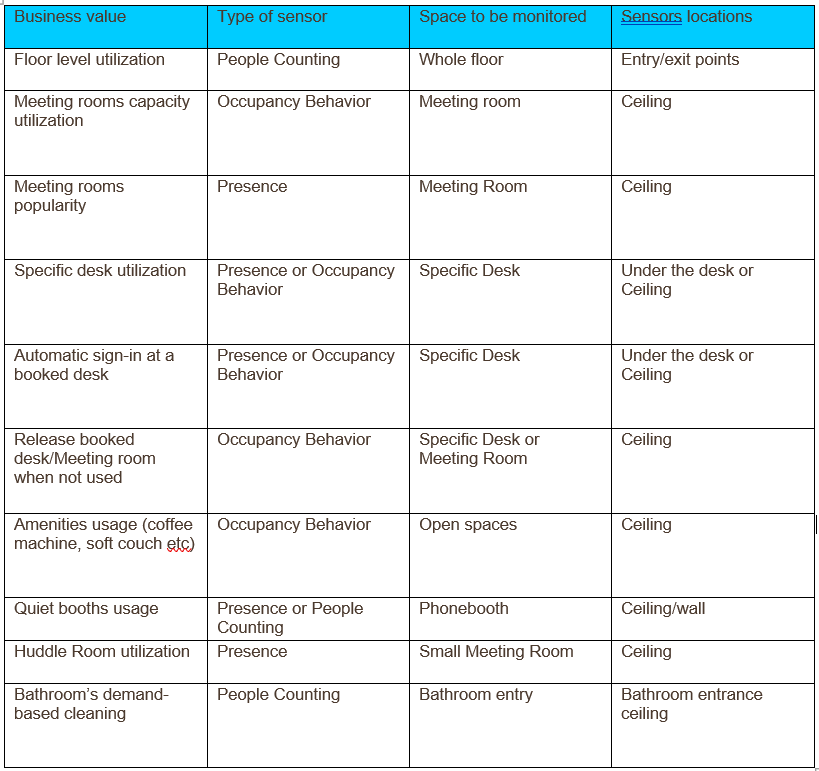Occupancy Sensors Technologies

Mapping the Right Technology To Your Need
In modern workspaces, choosing the right sensor technology is critical for optimizing efficiency and enhancing occupant experience. Each type of sensor offers high detection accuracy while maintaining full anonymity. However, matching the technology to the appropriate use cases is essential for optimizing space costs, operational efficiency, and user satisfaction.
Let’s dive into the three common sensor types and their applications:
Presence Sensors:
Leveraging Passive Infra-Red (PIR) technology, these sensors are simple devices designed to detect motion within it detection area. With a detection radius of up to six meters when mounted on a standard ceiling, they provide reliable indicators for people movement, thus change in presence within a space- to turn on the lights, change occupancy sign status etc.
Advantages:
- Accurate Motion Detection: Reliable for detecting positive motion events.
- Efficient and Cost-Effective: Low energy consumption and easy installation with simple one-way communication.
- Independent of Lighting Conditions: Performs well in various environments.
Limitations:
- Inaccuracy due to lack of motion: familiar with the handwaving to turn the light back? the lack of motion triggers a timer…
- Inaccuracy on “Turn Off” Events: Presence sensors do not positively detect when a space is no longer in use, a rigid timer based solutions are often leading to inefficiencies
- Lack of Detailed Data: Cannot detect the number of occupants or distinguish between areas within the detection range.
- Limited in Irregular Spaces: Circular detection zones may leave blind spots in non-standard room shapes.
People Counting over a Virtual Line:
This technology, included in solutions like PointGrab’s CogniPoint, tracks movements across virtual thresholds, counting people entering or exiting a defined space. Ideal for entryways and large areas, these sensors offer insight into traffic flow and cumulative counts.
Advantages:
- Cost efficient model to count people in a large space: measured on the entry and exits
Limitations:
- Expensive: Using sophisticated image analysis algorithm and advanced 3D optical components translates to high device costs
- No Granular Insights: Once inside, occupant behavior and distribution are not tracked.
- Accuracy in an accumulative numbers: the ability to define in any given moment the net occupant number is dependent on directional algorithm counting errors and can be significantly off in small traffic numbers
Occupancy Behavior Sensors:
Advanced sensors like the PointGrab’s CogniPoint redefine occupancy monitoring by capturing real-time, granular data on how spaces are used. These AI-powered sensors detects the number of occupants within defined areas of interest. .
Advantages:
- Accurate number of occupants per space: from a meeting hall to a bank of desks, and from cafeteria to collaboration sofas or reception hall
- Fine coarse granular monitoring: Define areas of interest inside the space (like a specific desk, cafeteria service line or reception’s couch)
- Real time data: supports dynamic changes in counts in real time, to optimize energy, release assets and present real time occupancy on digital signage
- Future Proof: with Over The Air features updates, such as objects detection
Limitations:
- Professional Installation: Sensors needs to be positioned accurately per floor plan to count in the granular specific areas
- Annual subscription: data is available via simple Cloud API for various subscribers

Understanding the strengths and limitations of different occupancy sensor technologies is vital for optimal technology choice. With real-time data on a space usage, facility managers can make informed data driven decisions to optimize their assets and operations in times of uncertainty. The occupancy data, integrated into booking systems, building management systems and utilization analytics can then improve employee experience and reduce real estate and operational costs
Selecting the right sensor depends on your needs. The PointGrab CogniPoint includes all 3 sensor types in one hardware device and all data is available across all spaces from a single Cloud API
This “all in one” approach saves on replacement stock, offer flexibility in projects deployment and a simpler and secure data operations
